From Elite to Rollercoaster Tycoon: The Story of Simulation Games, Part 2
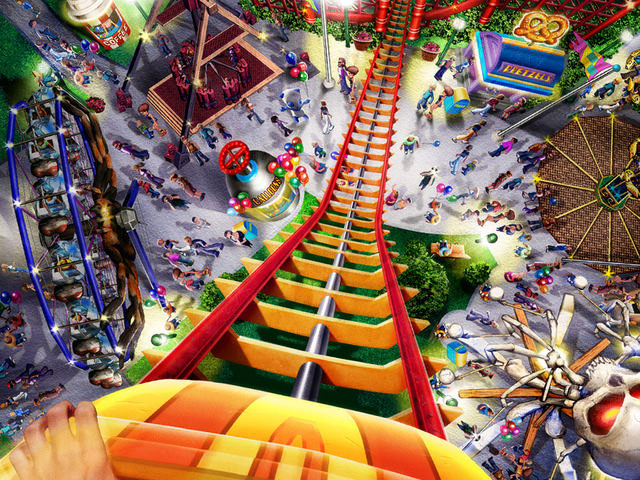
In the first part of our epic history of video game simulators, we deeply studied the simulators of society, politics and man. But simulators always showed themselves well in another: they allowed people to control equipment worth many millions of dollars.
Learn to fly
Flight simulators in various forms existed even before the invention of the microcomputer, but never really entered the amateur market, at least in any complex form. That was before the creation of Bruce Artvik at the end of 1979 Flight Simulator .
Given the computing power of personal computers of the time, the first version of Flight Simulator inevitably had to become simple, with tile-based graphics, braking frame rates and a rudimentary instrument panel that occupied half of the screen. But over the following years, it has evolved significantly, especially after the rights to the game from the company ArtLick's subLOGIC in 1982 were licensed by Microsoft.
The game gradually increased the quality of graphics, created more accurate simulations and increased depth, including adding new game modes and flying machines (of all forms and kinds), as well as user-generated content (which was originally introduced through hacks, and then began to be officially supported in the release 1989 Microsoft Flight Simulator 4.0 ).
')

Legendary Flight Simulator . Screenshot taken from version for Apple II.
A veteran of World War II and former test pilot Chuck Yeager became the technical consultant for the popular Chuck Yeager's Advanced Flight Trainer (1989), who simulated 14 aircraft. The flight was accompanied by comments from Yeager himself - sometimes useful, sometimes motivating, often entertaining.
In 1990, SubLOGIC released its first Flight Assignment: ATP simulator after Flight Simulator , making an application for the role of the first company simulating the work of civil airlines, including the rudimentary implementation of air traffic control.

SubLOGIC ATP
Among other notable non-combat simulators were Flight Unlimited (1995), in which ground textures overtook their time and gas dynamics were introduced for the first time instead of direct control of aircraft movements, as well as X-Plane , which was not a game, but rather a complete medium of a flight simulator, allows you to fully customize the map, the environment, the plane, the user interface and more.
By the end of the century, Flight Simulator became so deep and detailed that novice pilots could use it for training. In the 2002 version, an aircraft with artificial intelligence was added, complicating the air routes and communication with airports, and a three-dimensional virtual cockpit was introduced. This further reduced the gap between the experience of piloting a virtual aircraft and flights on the present.
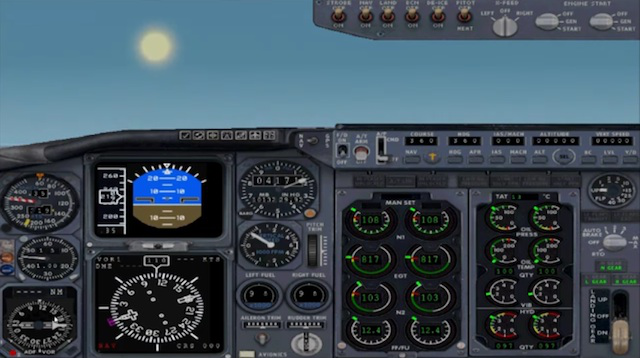
Flight Simulator 2002
Highway to the danger zone
While Flight Simulator and ATP (and later X-Plane ) proved to be mandatory for civil aviation amateurs, there were others who added a bit more interest. Before the advent of first-person shooters, combat flight simulators made it possible to experience an incredibly exciting experience of fights and first-person skirmishes.
Notable combat flight simulators include Fighter Pilot (1984) from Digital Integration, Jet (1985) from subLOGIC, and F-15 Strike Eagle (1985) from MicroProse. All of them suffered greatly from technical limitations. The Falcon series began in 1984 with the F-16 Fighting Falcon for MSX, but "took off" only after the release of the Falcon in 1987 for the Macintosh: raster graphics, detailing and realism became the hallmark of the series. Amiga users could try the exclusive F / A-18 Interceptor release (1988), which used the unusual entourage of the San Francisco Bay Area; The game was recognized as the best flight simulator for the Amiga.

F / A-18 Interceptor connected arcade control with realism simulator.
While the Falcon series continued to increase realism, Dynamix and Electronic Arts sought to make combat flight simulators accessible and interesting for players: they released Red Baron (1990) and Chuck Yeager's Air Combat (1991).
The Red Baron used exclusively fighters of the First World War. The game allowed to participate in close combat and in several other types of missions, and despite the simplified physics, it had a simulation of gyroscopes, jamming of weapons and damage to airplanes. Air Combat also sacrificed realism to a more interesting gameplay, but retained enough physical simulations so that the game did not feel like an arcade game.
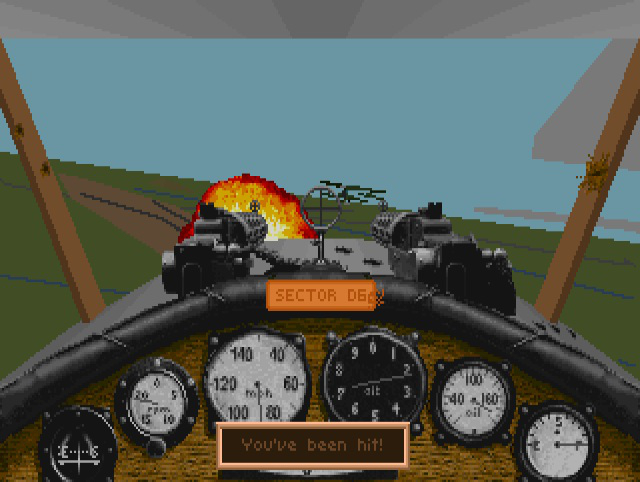
Close air combat was the strength of the Red Baron .
Electronic Arts competed in realism with the Falcon series of games released under the brand name Jane's Combat Simulations, the first of which was Advanced Tactical Fighters (1996). But the best combat flight simulator was developed by former aviation engineer Oleg Maddox and his Maddox Games team.
IL-2 Attack , a simulator in the subject of the Second World War, named after the Soviet fighter-attack aircraft, after a long development cycle was released in late 2001 and quickly made a name for itself in the gaming community. Maddox realized that the computing power of computers required compromises, but he still adhered to the desire to create as detailed as possible physics, while maintaining good graphics and AI. The result was the most reliable flight simulator on the market, at least until the first sequel appeared in 2003, Forgotten Battles . Somehow, the developers managed to create a sense of lack of control: the player barely kept the plane in the air, he was tormented by gravity, powerful gusts of wind and a strong torque.

The game IL-2 Sturmovik , despite the deep simulation of the Second World War fighters, managed to create good graphics.
The game attracted a keen and knowledgeable community that created high-quality mods and helped developers fine-tune parts, even engine performance at different heights and simulate individual cylinders. (However, novices were not excluded from participating in the fun - to create a more casual gameplay, realism could be reduced.) IL-2 Assault: The Battle of Britain , the sixth part of the series, was released in 2011, and provided even more realism, complexity and extended content that have become the hallmark of the series.

Series IL-2 Attacker does not give up the slack, impressing us with every new part.
Send a helicopter
Tomahawk (1985) of Digital Integration, Gunship (1986) and Apache Strike (1987) MicroProse Software were among the first helicopter simulators. These games resembled simulators of jet and combat aircraft of the time: the player looked at the action from the cockpit, controlling speed, direction and altitude, shooting at targets from various weapons. Each game used its own type of helicopter (usually a variation of the AH-64 Apache) and offered a series of missions, each of which had several ground and air targets. Although the physical systems at that time were still forcedly simple, these early helicopter simulators, compared to other air battles simulators, gave the player a different game pace - the helicopter’s flight has other difficulties: it flies and fights close to the ground, and in combat it sometimes has to hover on the spot, fly sideways or back.

Gunship - one of the first helicopter simulators.
In 1992, NovaLogic Comanche: Maximum Overkill made the most of the power of computer graphics. Simulation aspects were not so vividly expressed - despite the stated “most realistic helicopter simulation” of that time, they were abandoned to demonstrate the capabilities of the engine, which used voxel technology , which created a much more detailed relief than the vector or raster graphics of competitors. The game was interesting and full of action, but fans of the true simulator helicopter battles had to wait a few more years.

Comanche had incredible graphics at the time.
With the release of Apache (aka Apache Longbow ) in 1995, Digital Integration showed how far technology had gone in ten years after the release of Tomahawk . Although the graphics of the game seemed weak compared to the Comanche series, Apache had a deep and realistic simulation mode, fortunately provided with a detailed workout mode. However, he retained the title of the most realistic helicopter simulator for only about a year - in 1996, Origin Systems laid out AH-64D Longbow on store shelves. Longbow defeated Apache on all fronts - it had a terrific graphics schedule, superb leadership, difficulty changing, hyper-realistic simulation of an Apache attack helicopter, a system of various missions, intelligent AI, and two full campaigns. For all this, we had to pay performance - for a normal Longbow operation a very powerful machine was required.

AH-64D Longbow is still one of the most realistic helicopter simulators.
More modern helicopter simulators, such as Apache Longbow Assault (2004) and DCS: Black Shark (2009), continued to develop innovations of these games, they became more realistic, added new functions and new models of helicopters. Helicopters began to appear in some other flight simulators, such as Flight Simulator and X-Plane , but over the past decade, nothing truly innovative happened in the helicopter simulator genre.
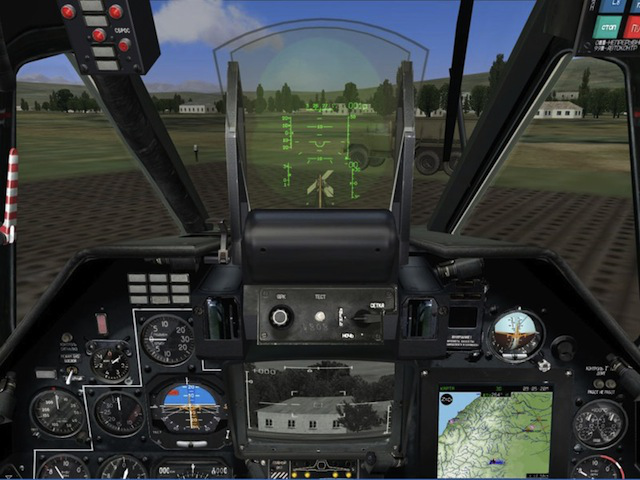
DCS: Black Shark
Lost in space
The concept of interstellar trading, very important in games such as Freelancer , Wing Commander: Privateer and EVE Online , first appeared in the 1974 Star Trader game written on BASIC. In it, the player moved on a star map, choosing trade routes. Star Raiders (1979) chose a more militant approach, adding a first-person perspective to the game. But the concept itself gained popularity only a decade later. Space simulators and, to a lesser extent, open-world games owe much to Elite Ian Bell and David Braben.
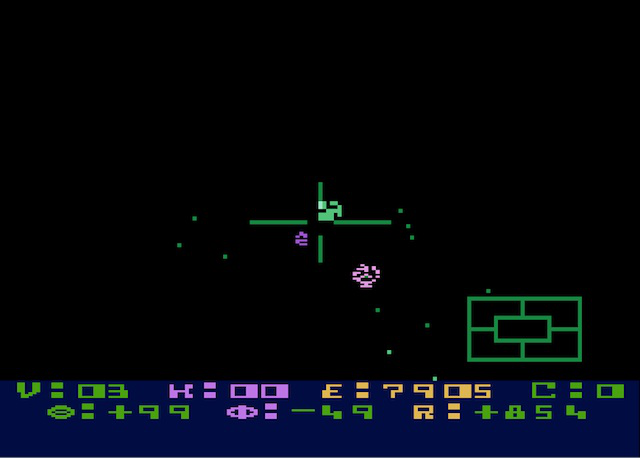
Star Raiders is well remembered by those who played in it.
Elite , first released in 1984 for the BBC Micro home computer available only in the UK, gave players the opportunity to become the commander of a merchant ship in a huge universe (the contents of which were stored algorithmically). By participating in various enterprises, including piracy, mining and military missions, as well as trading, the player earned money that could be spent on improving the ship and buying a new one. Elite structure was completely open. Most of all in it attracted the same thing as in many subsequent space simulators: the ability to move anywhere, do anything within a very deep gameplay system and a huge universe.

Elite on BBC Micro
It was followed by several mediocre clones and excellent ports, as well as less simulator and more arcade games about space battles, while the genre of space simulator experienced stagnation. Everything changed in the early 90s, the genre began to grow rapidly, and many owed it to the birth of a legend.
The popular Wing Commander series by Chris Roberts and Origin appeared in 1990. The first game of the series took the Star Wars formula, mixing drama with terrific space battles and transforming them into a video game format. The high quality of the game made it possible to defeat all competitors: almost cinematic plot, impressive graphics, which delayed the player in the game world, arcade-style battles and a dynamic soundtrack. However, many believe that Wing Commander (and its sequels) was not a “real” simulator: it was something like a Hollywood version of a simulator that seemed more important to be realistic or reliable (for an inexperienced player).

Wing commader
With the launch of the LucasArts X-Wing project in 1993, the Star Wars franchise finally gave its Wing Commander series of responses in the form of a video game. X-Wing spawned three sequels, each of which became more and more like a simulator, and seriously competed with Wing Commander in sales, and in reviews of critics. X-Wing and its sequels, playing in the game exciting battles from Star Wars films, have a lot of fans.

X-Wing today is one of the best video game adaptations of the Star Wars franchise.
Technological advantages allowed Escape Velocity (1996) to become the game that Elite could not become due to the limitations of memory and graphics. Despite its two-dimensionality, it was huge - an ever-expanding star map, filled with a mixture of everything and nothing, conveying the vastness of space better than any other game before it. But the game was released only for Macintosh, and this platform was ignored by many lovers of space simulators.
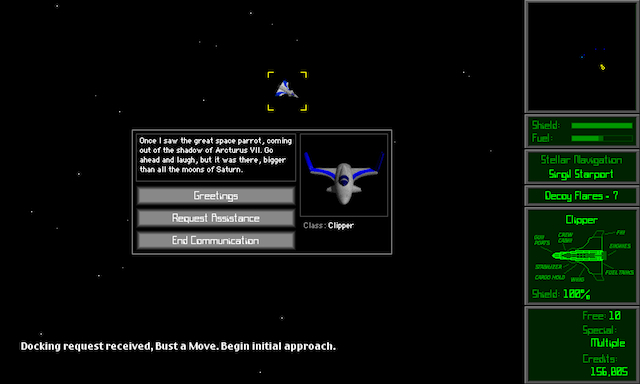
In Escape Velocity, a player could communicate with other pilots of ships, communicate with the nearest planets and space stations.
It’s not that the Elite- inspired space simulator alternatives were bad - Wing Commander: Privateer (1993) and its sequel Privateer 2 (1996) added the open world and elements of commerce to the Wing Commander cinematic storyline. These games, like most space simulators, had a steep learning curve - players had to learn to juggle several types of camera, screen radar, difficult controls (there was almost nothing to do without a joystick) and a variety of tasks. But everything was presented so well that for several years the genre of space simulators proudly towered on the PC-games market.
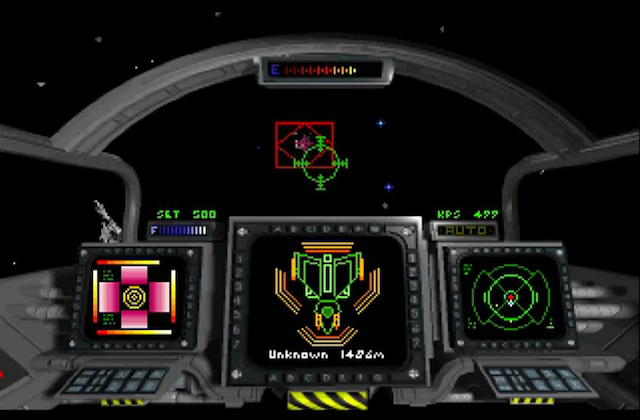
Today, Wing Commander: Privateer remains one of the favorite space simulators.
Even despite the fact that the popularity of first-person shooters and consoles ousted simulators - and especially space simulators - into the background, the genre of space simulator continued to impress. Descent: FreeSpace ( Conflict: FreeSpace — The Great War in Europe) and its sequel to FreeSpace 2 are considered the two best space simulators because they more or less brought to the state of the ideal space trade and open world fights . New FreeSpace 2 mods are being actively developed to this day (thanks to the work of the FreeSpace 2 Source Code Project, fan-driven). Some of them, including Beyond the Red Line , Shadows of Lylat , and The Babylon Project, have become complete conversions, expanded gameplay and replaced graphics and other content.
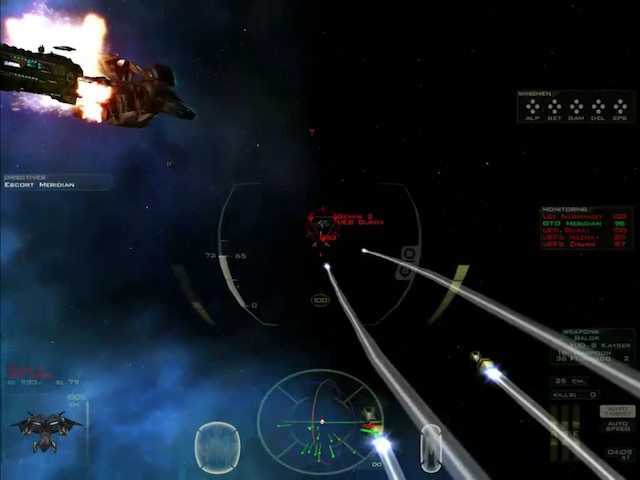
FreeSpace 2 is considered the most cosmic simulator by most players. This screenshot was taken in the Blue Planet mod.
In depth
Today, submarine simulators, or “subsims,” as the fans call them, survive in the face of open-source Danger from the Deep and the frankly complex Silent Hunter series (and possibly Steel Diver for the Nintendo 3DS, if it manages to build a similar fan base ). But once the market of underwater simulators was much more alive. The first in 1982 for the Intellivision console was Mattel's Sub Hunt , followed by Spectrum Holobyte's GATO . Sub Hunt gave players the ability to control four submarines (one at a time), which were supposed to prevent or stop the invasion of the player’s home island. This was implemented in two game modes: Deployment mode allowed submarines to move orders before meeting with the enemy, after which the game went into combat mode - view from the skip and sonar screen, with which you could control the depth, speed and position of the steering wheel, as well as release torpedoes (with an infinite supply).

Battle Mode Sub Hunt
However, the most important submarine simulator of the 80s was Sid Meier's Silent Service . Taking as its basis the utterly clichéd entourage of the Second World War, but the less clichéd Pacific theater of military operations, Silent Service contained detailed instructions with information about historical combat tactics and their effectiveness. And the game itself was as attentive to the details as its leadership.

DOS version of Silent Service
Shut up and drive
Almost everyone at some point in life had to drive a car, and naturally there are simulators that allow you to drive in the virtual world. The standard of driving makes them unique among vehicle simulators because they rarely simply recreate the process of driving a car through country roads or in a city — the player needs the tension of high speeds, the novelty of exotic locations or the feeling of being driving a luxury car, a huge truck, a racing car or even a policeman car.
Racing simulators are much better explored in the wider context of all racing games, but nevertheless they remain simulators - so I will briefly describe their evolution. The success of the game for arcade machines Pole Position (1982) from both developers and consumers has an interest in games that accurately simulate the driving experience in Formula 1 and other types of professional racing. In 1985, the Hang-On motorcycle appeared on the arcade machines: the players would sit on real motorcycle mockups, which could be tilted from side to side, driving. But the true simulation of racing began only with the release of the company Papyrus Indianapolis 500 in 1990. Throughout the 1990s, Papyrus improved its formula for unsurpassed racing realism, breaking sales records for stunning NASCAR Racing (1994), setting the standard for all other simulators and paving the way for other popular simulators such as Gran Turismo (1997). In the meantime, MicroProse managed to attract the attention of the racing community with the Grand Prix 2 game (1996), a highly realistic Formula One simulator with excellent customization of cars. The 1998 Papyrus Grand Prix Legends game surpassed everyone else in terms of realism, presenting the unusual entourage of the 1967 Formula 1 season, but scared the fans with high technical requirements and terrible complexity.

The impressive damage modeling of NASCAR Racing made the crashes interesting ... but destroyed hopes of victory.
Console races were mostly represented by arcade games, until in 1997 Polyphony Digital released the PlayStation Gran Turismo for Sony. Incredible detailing and the open Gran Turismo open final were compromised only by the lack of damage modeling. But this did not reduce sales - the Gran Turismo series , in which five main parts appeared, has sold more than 60 million copies worldwide. Later, she had competitors in the face of the GTR and Forza series, various Formula 1 and rally simulators (the most prominent were the Colin McRae / Dirt series) and Live for Speed online racing simulators.
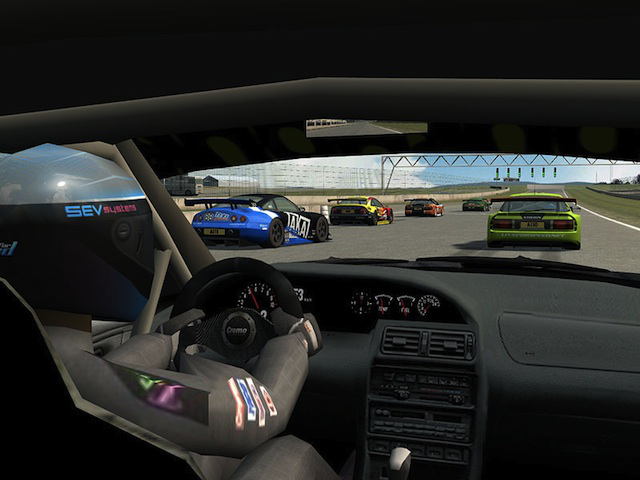
Live for speed
In the non-driving category of driving simulators, there was a little remarkable - probably the developers were afraid to take risks while making a commercial driving game, not related to racing. Truck simulators, for example, a series of 18 Wheels of Steel were produced with low budgets, received mediocre sales and occupied very narrow niches. There were very few other games on the market. Hard Drivin ' (1988) with realistic driving physics in a fantastic environment with huge loops of tracks most likely became the first (and most successful) driving simulator without racing.
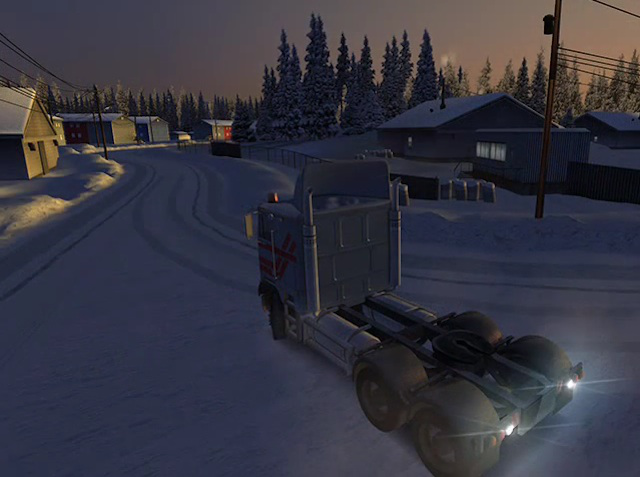
18 Wheels of Steel Extreme Trucker .
Fighting on mechanized and armored vehicles
Considering the fact that tanks are able to blow up everything, it is difficult to understand why they do not participate in more simulators. Of course, one cannot say that there are no tank simulators at all. Arcade games Tank (1974) and Battlezone (1980) can be considered the first such games, although in both of them there was not so much simulator. A more serious attempt was made in 1989 with the release of M1 Tank Platoon , in which an unusual 3D landscape appeared for that time. The game allowed you to switch between direct control of several pieces of equipment, each of which was under the command of a player. The console game Super Battletank (1992) combines elements of simulation and action. The main role in the game was played by the tank division participating in the operation “Desert Storm”. Tank simulators went into the shadows before the 1998 release of M1 Tank Platoon II , which was soon followed by iM1A2 Abrams and the popular Steel Beasts which defined the genre.
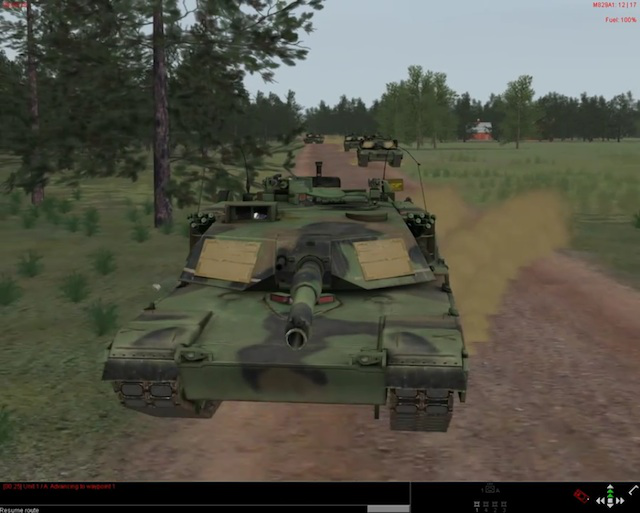
Steel Beasts Pro PE is the most modern version of Steel Beasts .
Steel Beasts gave the player the opportunity to perform the role of one of the crew members (for example, commander, gunner or driver) of a tank or other armored combat vehicles. The game features intelligent AI, authentic sounds, realistic action, popular themes, a map editor, and multiplayer game modes. The game developer, eSim Games, even developed a version of Steel Beasts specifically for military training. Meanwhile, a team MMO World of Tanks was released, the developers of which apparently hoped to capitalize on the success of eSim Games. The game features a fairly accurate simulation of about 500 vehicles, most of which are tanks.

Free MMO World of Tanks quickly gained popularity.
Futuristic pro-combat games involving armored or mechanized units tended to be more prone to action / arcade or RPG than to the simulation genre. Of the several mech simulators (think of a walking tank!), The most visible were the Armored Core series (1997 and on), MechWarrior (1989 and on), Steel Battalion , together with the Front Mission series more focused on RPG (1995 and on) . These games featured a wide range of gameplay styles, even within the same series. But common to them were the modularity of the parts, which had certain tasks and internal systems, a noticeable influence of the BattleTech wargame and anime.

MechWarrior 2 is probably the first mech simulator (the first MechWarrior was more like a clean action).
On rails
Those who like trains should not stop at transport managers like Railroad Tycoon and Transport Tycoon ; special railway simulators have existed for a long time already, in which trains themselves play a central role. Such games gained their popularity even in the face of early train simulators, for example, Southern Belle (1985), which critics considered dull and meaningless.
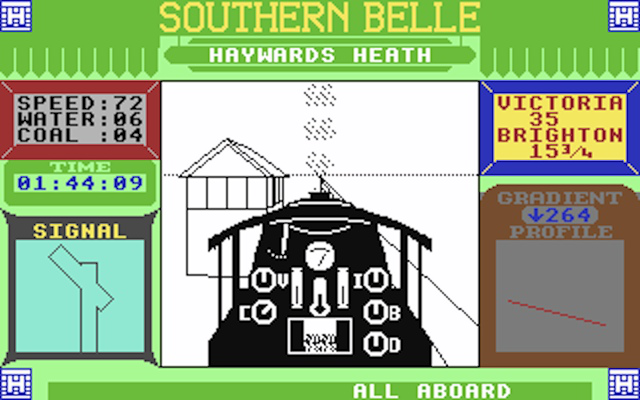
It's hard to find a less interesting game than Southern Belle.
Today, train train simulators are dominated by the Microsoft Train Simulator / Rail Simulator / Railworks and Trainz series , founded in 2001. Each of them meticulously recreated the work of railways and trains. Trainz is closer to the digital version of the designer of the railway, while the Rail Simulator games offer to travel on real rail routes around the world. They have two alternatives in the face of free simulators BVE Trainsim and Mechanikwhich place great emphasis on the simulation of the dynamics of train movement, including a 3D cab driver. At a certain point in time, Mechanik was considered the best train simulator with a view from the cabin, but a reduction in work on the project and poor graphics put an end to the game.

Due to the outdated graphics and interface, Mechanik overtook more modern games such as Trainz and Rail Simulator .
We run a business
Despite the dryness of financial reporting, accounting, and business economics, there are many games that seek to simulate the practice of capitalist business. The most famous among them were various games with the word "Tycoon" in the title, of which the most popular were Railroad Tycoon , Transport Tycoon and RollerCoaster Tycoon . However, business simulators are not always associated with construction and management, they have more diverse topics, in addition to managing transport networks or amusement parks.
One of the first such games was Windfall: The Oil Crisis Game (1980) for the Apple II. Designed by David Müllich, best known for his contributions to I Have No Mouth and I Must Screamand in the Heroes of Might and Magic series , and Edu-Ware's published game, Windfall demanded that players manage the fictional Engulf Oil company in a world that had survived the energy crisis. The player had to keep track of supply and demand, set prices and wages accordingly, not forgetting that low wages of workers can cause discontent, and too high prices will lead to the victory of competitors. The early multiplayer strategy game MULE (1983) also simulated the economy of supply and demand, paving the way for strategies with complex elements of the simulator, and simulators dedicated to economic management.
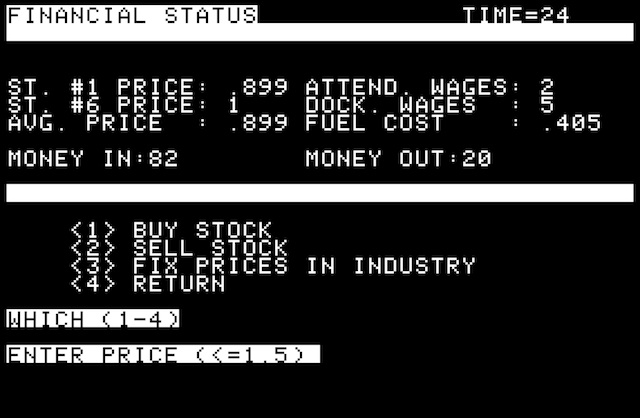
Windfall is a game that takes place almost entirely in text menus.
With the release in 1995, Capitalism Enlight Software spurred the stagnant genre of a business simulator, which still survived thanks to railroad management simulators Railroad Tycoon and A-Train . Being the CEO of a new or existing company, a player must grow their business through research and development, shopping, manufacturing, retail sales, venture capital, investing in stock markets, farming and mining - everything depended on the industry chosen, game mode and difficulty levels. The game was so realistic and deep in its business simulation that it became an educational tool at Stanford and Harvard.
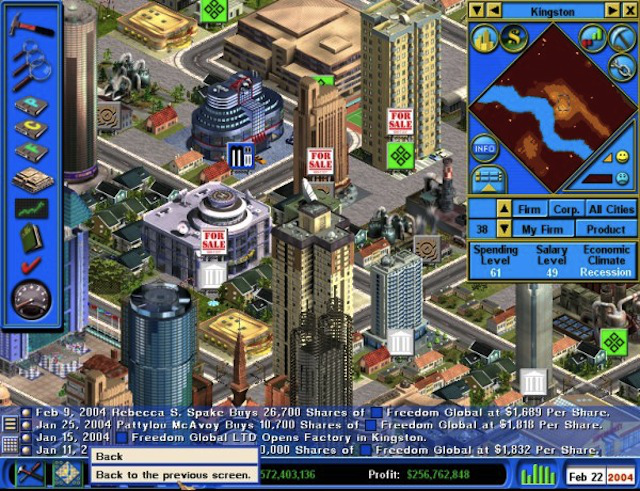
Capitalism 2 , in essence, was just an improved version of Capitalism .
Since then, business simulators have managed to participate in the management and financing of almost everything - the zoo, shopping center, restaurant, trade on Wall Street, hospital, hotel, prison (yes, in fact -there are four gamesin the Prison Tycoon series) film studios, gaming companies and even lemonade sales (although you can bet whether Lemonade Tycoon is betteras a game or a simulation than the minimalist Apple II Lemonade Stand classics).

Hollywood Tycoon is one of a variety of casual tycoon games. However, unlike many, she was really decent.
It is in business simulators that the genre of simulator created not only the largest number of simulated activities, but also the greatest scalability (in terms of the scale of enterprises and target platforms), and possibly the most number of games. Unfortunately, this variety is more related to quantity than to quality - there are much more disgusting business simulators than good ones. Before moving on, let's consider only the most decent.
Traffic Simulators
Although Sid Meier’s greatest contribution to video games was without a doubt a series of turn-based strategies for Civilization , his legacy is much richer and not limited to this franchise. A year before the release of his main work, Meyer worked on the design of a game about the construction and management of railways. The attractiveness of the Railroad Tycoon extended far beyond what was expected by train fans: players could easily take part in a tough competition in the battle for dollars of passengers, trying to outrun competitors in road coverage, train speeds and prices.

Railroad Tycoon
The game, known in the West as the A-Train, was in fact the third in the popular series of Japanese railway control simulators Take the A-Train . She fought for popularity in the United States, despite being more like SimCity 2000 than Railroad Tycoon or Transport Tycoon . Unlike other railway control simulators, A-Train gave the player a monopoly - full control over all railways in the city, both passenger and freight.
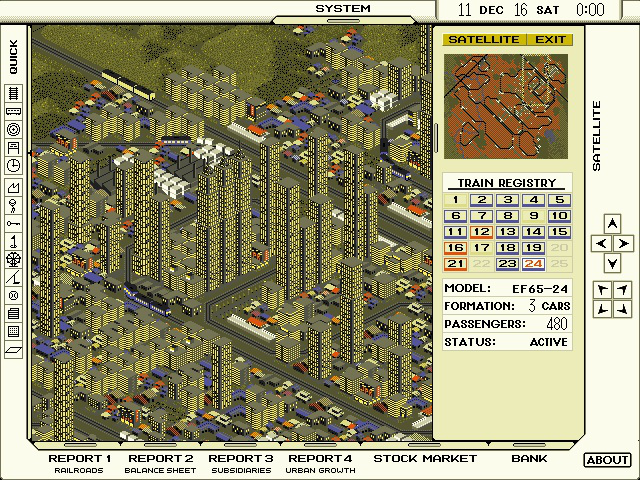
Despite its popularity in Japan, the A-Train did not succeed in the West.
Transport Tycoon Chris Sawyer overtook Railroad Tycoon due to the fact that the player’s transport empire has grown into highways, airways and waterways. The player has watched the ups and downs of technology and industries throughout the time frame of the game, from 1930 (1950 in the Deluxe re-release ) to 2050. The user's company constantly had to adapt to the available resources and customer requests. In 1995, the Deluxe version was released., in which new maps appeared and bidirectional signals were removed, which allowed two trains to move along the same rails in opposite directions. The game caused the appearance in the early 2000s of two open-source remakes, the development of which is still ongoing. OpenTTD aims to expand the graphics and gameplay of the original, and Simutrans should have become a deeper and more realistic simulator. Meanwhile, the later released Cities in Motion offered players a more SimCity-like view of transport management.

OpenTTD . This screenshot is made from the saved game file taken here .
Let them nauseous
Amusement parks are interesting, so it seems logical that a game about building and managing such a park will also be interesting. Bullfrog Productions made a logical step by releasing Theme Park in 1994 , which gave players an empty piece of land and a sum of money. The user's seemingly simple task was to create a profitable amusement park that attracts people with amazing roller coasters and trampoline locks, and then hold them there with the help of annoying animators, rooms of crooked mirrors, traveling in huge tea cups, sweets and any other ways make part with hard earned money. Theme parkHe added a British flavor to the signature humor of the Maxis sim games, and another level of accessibility - the game was easy to start playing, but difficult to achieve mastery in it. Bright graphics, optimistic music and friendly design opened up business simulators for a wider audience, as years later The Sims did the same for life simulators.

If Theme Park taught me something, it's that the trampoline locks are very easy to destroy.
Theme Park also allowed Transport Sewer, creator of Transport Tycoon, to pave the way for RollerCoaster Tycoon.(1999), a deep and challenging game about managing an amusement park with a focus on building your own “roller coaster” (which could be shared and exchanged with other players). Many players had fun building a "death hill", the exits of which were located underground, above water, near a cliff or in another place where the likelihood of a crash is high (visitors were too stupid to understand that you should not take such dangerous rides). However, if a player wanted to build a working and safe amusement park, then RollerCoaster Tycoongave him incredible depth. Visitors had different preferences regarding the type of slides and different levels of delight. It was necessary to keep track of the weak stomachs, which could have been torn out after the innocent carousel, and the risk-takers who wanted to feel the almost deadly danger on an incredibly intimidating roller coaster. To find the right balance and location of rides, tracks, free entertainment, food, drinks, fairground games, recreation areas and open spaces, it took a lot of time to plan.

A challenging but fun RollerCoaster Tycoon Two more games and several extensions followed the
release of the RollerCoaster Tycoon . RollerCoaster Tycoon 2 (2002) remained an improved version of the first part, and RollerCoaster Tycoon 3 (2004) attracted fans and graphics quality, and the possibility of building customized fireworks shows. In the third part, the franchise also added a “sandbox” mode, which was very lacking in previous games, as well as a new look, which made it possible to enjoy first-person rides. Unfortunately, these additions appeared at the cost of abandoning the deaths of visitors, destroying most of the fun from the construction of the “roller coaster” doomed to disaster.

- , , .
Japanese developer Kairosoft made a splash in the video game industry by releasing the English-language localization of the game for PC and mobile phones Gēmuhatsu Tenkoku , or Game Dev Story in the version for iPhone (it was followed by the version for Android). In Game Dev Story, a player controls a video game development studio. Starting with two inexperienced developers and empty pockets, the studio gradually turns into a large whale industry. Despite the simplicity of the gameplay and the superficiality of the simulation, the game impressed with the accuracy of its parody of all aspects of the industry (at least in the early stages) and became an excellent example of the fact that the business simulator does not have to be difficult to entertain the player and teach him to manage people, money and other resources.
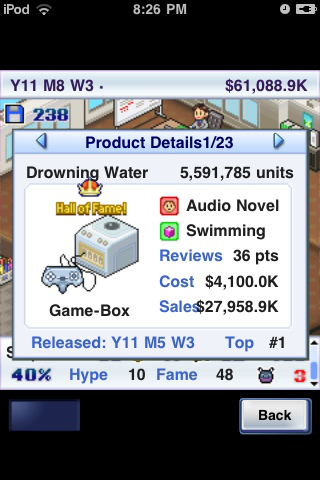
, « »?
Medical simulators soared to the peak of popularity in 2005, after the release of the Trauma Center: Under the Knife for the Nintendo DS. Trauma Center told the linear (and ridiculous) story of Dr. Derek Stiles, who wants to save the world with her newfound “healing touch”. The main attraction of the game was its pseudo-realistic surgical operations, the origins of which seem to lie in the 1988 simulator Life & Death . Life & Death, much more realistic than the Trauma Center (but still remaining a yoke), turned the player into an abdominal surgeon who needed to diagnose and treat patients at Toolworks General Hospital. Irresponsible decisions or erroneous views could become a matter of life and death for patients. With every mistake, the protagonist was sent to the class, where they read a lecture about what he did wrong. In the sequel, Life & Death 2: The Brain , improved graphics and deeper (but otherwise similar) gameplay appeared, only this time the player was a neurosurgeon. The list of other games with a hospital theme includes Hospital Tycoon (2007) and Theme Hospital (1997), in which the player managed the hospital and its staff.
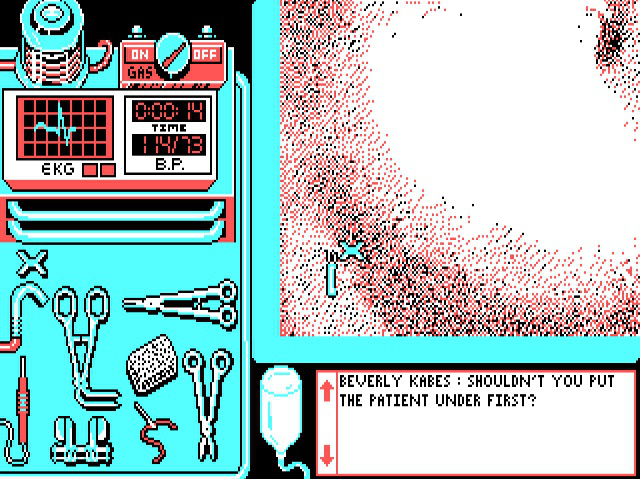
It seems that when a patient is consciously cut with a scalpel, it hurts him.
Casual vs Hardcore
The terms "casual" and "hardcore" got a new meaning in the simulators - they relate more to the level of realism, and not the depth of the gameplay. The casual simulator is similar to the “simulator-lite” - availability in it is valued above accuracy, and its learning curve is much simpler than that of hardcore. It can still have a considerable depth of settings and possibilities, but such depth is not required to enjoy the game. Most simulators released in the 80s and early 90s would be considered casual today, because they are much simpler than the games that they were inspired by.
This is one of the biggest problems in making a simulator popular today. Games of the genre are mainly divided by levels of detail and realism. There is a strong motivation to make simulators more real, more life-like and more complex. But at some point it scared the genre of its casual lovers. Only the most committed players are willing to spend long hours studying management before they can take the plane to the runway or build a city with a working — even not necessarily efficiently — transport system.
The race for specialization and the race for realism took place in parallel and both of them led to the escape of mainstream players. (And the surplus of primitive games that appeared in the late 90s and continues to this day also did not help simulators.)
Where to go next?
Although many video games over the past decade have become easier, now they are more friendly to beginners, but at the same time other games have improved their “hardcore” functions - simulators have become more and more complex and complex. There were exceptions to this trend, and not only in the areas of browser and mobile games, but such exceptions are usually just alterations to old games. The work of the indie community, striving for hyper-realistic and complex simulators, preserving the fascination of old games, is invaluable for the future of simulators.
But there is also a huge need for a new hit at the intersection of audiences, especially in the increasingly niche genres of the space and flight simulator. You need something like The Sims , Wing Commander , Red Baron , RollerCoaster Tycoon , Theme Park , NASCAR Racing, or even Populous . Without such a hit, simulators (with the possible exception of The Sims and other life simulators) seem doomed to niche status. It is quite suitable for games such as Farming Simulator or Ship Simulator , but will not work for games like Tropico , Cities XL or Forza , which are not attractive for the mainstream and have a high production cost.
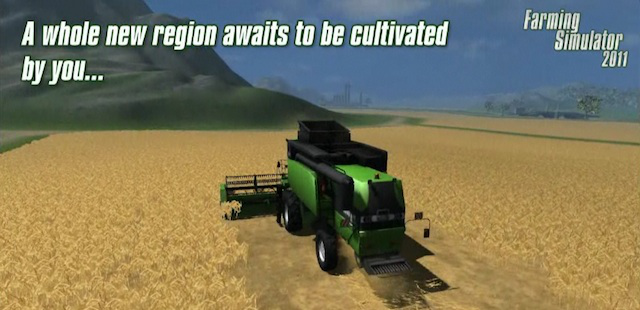
If this is the future of simulators, many people will be disappointed (although some will be delighted) .
At one time, the omnipotent space simulators especially needed a breakthrough hit, the genre completely disappeared from the radar screens of former fans, who gradually switched to console games. This is still true even after the appearance of the incredibly deep (and moderately popular) EVE Online , in which the economy is so complex that there are economists in the development team, and after the release of Star Trek Online MMO in the Star Trek universe.
Games like Grand Theft Auto have been replaced by space simulators for those who like to explore the vast open world, but the fact that such games are popular, combined with the enduring passion of humanity for space, tells us that there can still be a place in the world for games like FreeSpace Elite , Privateer and Escape Velocity , if only developers can find the right balance between depth, accessibility and an attractive appearance.
Source: https://habr.com/ru/post/374005/
All Articles